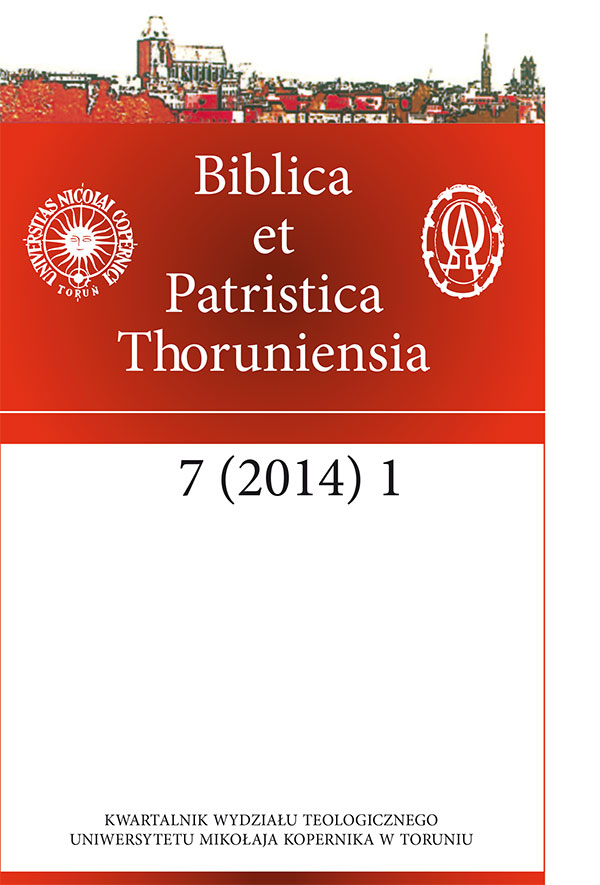Apostle Peter's way of faith in the light of the announcement of betrayal (Luke 22:31-34) and denial of Jesus (Luke 22:54b-62)
DOI:
https://doi.org/10.12775/BPTh.2014.002Keywords
Peter, faith, betrayal, denial, Jesus' prayer, foregiveness, conversionAbstract
One of the best known events in Peter's life are his three acts of denial of Jesus. The denial is referred to in all four Gospels (Matthew 26:58.69-75; Mark 14:54.66-72; Luke 22:54-62; John 18:15-27). What happened in the courtyard of the high priest's palace had been foretold by Jesus himself, though the accounts pertaining to this event given by the Evangelists are slightly different from each other, particularly in terms of the context and time of Jesus' announcement. According to Matthew and Mark the announcement was made after the Last Supper on the way to Getsemani (Matthew 26:31-35; Mark 14:27-31), whereas according to Luke and John it happened during the Last Supper as part of Jesus' farewell address (Luke 22:31-34; John 13:36-38). The subject of our deliberations is the account given by Luke the Evangelist, which illustrates perfectly well Apostle Peter's way of faith as the necessary act of experiencing one's own weakness and insufficiency, which results in turning oneself (converting) to the power of Somebody else. Moreover, Luke's version contains new essential elements which the other Evangelists are missing: Satan insisting on afflicting the disciples (22:31), Jesus praying for Peter that his faith would not fail and the prophecy – a promise that when Peter is converted, he shall strenghten his brothers (22:32).
In light of the analyzed texts, the way of faith does not always bring one from non-belief to faith. Sometimes it is necessary to embark upon the way which is harder and more demanding, the way which takes one from improper, false faith to the one which is proper and true. Peter's way of faith mirrored the latter. First, he put unconditional trust into himself. He relied on his faithfulness, which he declared openly, spontaneously and readily. He was ready to go with Jesus to prison and to death (22:33). Jesus knew that in order to cleanse Peter's faith, it needed to be shaken and go through a critical period. Jesus approved of such a situation in order to put Peter's faith to test. This approval, however, from the very beginning, had been ingrained with assurance and a promise that Peter's faith, even though put to test, shall not fail completely (22:32). One can say that Jesus, through experiencing three acts of denial, allowed the destruction of Peter's improper and false faith, which was based on Peter being convinced of his power and faithfulness. Peter then was brought onto the way of faith, which was the way of cleansing, conversion and strengthening in genuine faith based on Jesus' forgiving love (22:61-62).
References
Brandstaetter R., Jezus z Nazartethu, t. III-IV, Kraków 2005.
Cipriani S., Św. Piotr Apostoł , Kraków 2008.
Franciszek, Lumen fidei, Kraków [b.r.w.].
Gnilka J., Piotr i Rzym, Kraków 2002.
Kiernikowski Z., Posługa Piotra (Łk 22,31-32). Przewodniczenie w nawracaniu, w: S. Hałas, P. Włodyga (red.), Pan moją mocą i pieśnią (Ps 118,14). Prace dedykowane Księdzu Profesorowi Tadeuszowi Brzegowemu w 65. rocznicę urodzin, Kraków 2006, s. 85-99.
Langkammer H., Rola Piotra w pierwotnym Kościele, w: S. Szymik, H. Ordon (red.), Opoka Kościoła Chrystusowego, Lublin 2004, s. 17-25.
Maggioni B., Ewangeliczne opowieści o Męce Pańskiej, Kraków 2002.
Mickiewicz Fr., Ewangelia według świętego Łukasza, cz. II, rozdziały 12-24, Częstochowa 2012.
Oktaba P., Modlitwa Jezusa i Kościoła za Piotra (Łk 22,31-32), VV 6(2004), s. 129-145.
Wons K., Ty wiesz, że Cię kocham, Kraków 2010.
Downloads
Published
How to Cite
Issue
Section
License
CC BY ND 4.0. The Creator/Contributor is the Licensor, who grants the Licensee a non-exclusive license to use the Work on the fields indicated in the License Agreement.
- The Licensor grants the Licensee a non-exclusive license to use the Work/related rights item specified in § 1 within the following fields: a) recording of Work/related rights item; b) reproduction (multiplication) of Work/related rights item in print and digital technology (e-book, audiobook); c) placing the copies of the multiplied Work/related rights item on the market; d) entering the Work/related rights item to computer memory; e) distribution of the work in electronic version in the open access form on the basis of Creative Commons license (CC BY-ND 3.0) via the digital platform of the Nicolaus Copernicus University Press and file repository of the Nicolaus Copernicus University.
- Usage of the recorded Work by the Licensee within the above fields is not restricted by time, numbers or territory.
- The Licensor grants the license for the Work/related rights item to the Licensee free of charge and for an unspecified period of time.
FULL TEXT License Agreement
Stats
Number of views and downloads: 5764
Number of citations: 0



